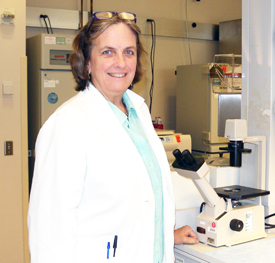Of Monkeys, Mice, and Men
The Promise of Hematopoietic Stem Cells
Cynthia Dunbar means business. Monkey business, that is. Dunbar, who heads the Laboratory of Molecular Hematopoiesis in the National Heart, Lung, and Blood Institute (NHLBI), is investigating human hematopoietic stem cells (HSCs), the precursors to all blood cell types. As it turns out, rhesus monkey (Macaca mulatta) and human HSCs are very similar.
Every year, between 45,000 and 50,000 people worldwide receive HSC transplants to treat life-threatening hematologic diseases, disorders that affect blood cells. “Most of the major advances in biomedicine have been based on hematologic diseases,” said Dunbar. “The first genetic disorder that was described and understood was sickle cell anemia,” a disease in which deformed red blood cells deliver less oxygen to the body’s tissues. Likewise, blood-related cancers as well as immune, metabolic, and red blood cell disorders caused by defective HSCs can be treated by transplantation of normal HSCs.

Susan Wong, NHLBI
Cynthia Dunbar, head of NHLBI’s Laboratory of Molecular Hematopoiesis, uses primate models to develop hematopoietic stem cell gene therapy approaches that have been successfully transferred to humans in clinical trials.
Dunbar first came to NIH in 1987 as a postdoctoral fellow in Art Nienhuis’s laboratory in NHLBI and worked on developing gene therapies to correct mouse models of hematologic diseases. In the gene therapy she employed, viral vectors deliver a functional gene into disease-stricken target stem and progenitor cells. The therapeutic gene becomes integrated into the host cells’ DNA and produces the missing or defective protein in all daughter cells. Nienhuis’s group successfully developed gene therapy vectors and methods to modify mouse HSCs and developed models for HSC disorders such as leukemia and other diseases.
By 1992, Dunbar and Nienhuis moved the gene therapies into human clinical trials, but the human patients did not respond in the same way as the mice. Less than 0.1 percent of corrected HSCs were found in the patient’s bloodstream long-term. “At that point we realized that mice were not people and it was time to find a more relevant model,” said Dunbar during her Clinical Center Grand Rounds Lecture on June 13, 2012.
And that’s why Nienhuis and Dunbar, quite literally, began monkeyin’ around in earnest. In the late 1980s, they had begun to develop a model to transplant HSCs into rhesus monkeys. “Antibodies, cytokines, and other critical reagents cross-react between human and rhesus [monkey] cells,” said Dunbar. “So you can directly use what you work out in the lab with rhesus [monkeys] and translate it into human clinical trials.”
But Nienhuis was initially hesitant to let Dunbar work in the rhesus macaque facility when she was a postdoc. “He didn’t think I should work on the primates because he didn’t think women should go into the building alone at night,” Dunbar recalled. “It was a different time.” However in 1993, when Nienhuis left NIH to become the chief executive officer of St. Jude Children’s Research Hospital (Memphis, Tenn.), Dunbar inherited the rhesus macaque facility. She relied on the critical knowledge and expertise of Robert Donahue, the veterinarian Nienhuis had recruited in 1990 to develop the primate model.
At first, just keeping the monkeys alive was a challenge. “Only half the animals would survive the [HSC] transplant,” said Dunbar. “But by the mid-1990s, it was rare to lose an animal from transplant complications.” Today, her laboratory uses genetic marking techniques as well as new imaging modalities to track, in monkeys, the output from individual HSCs, how long they last, and what blood cell lineages they contribute to. Dunbar’s laboratory used the primate model to develop HSC gene therapy approaches that have been successfully transferred to humans in several clinical trials. In 2000, 11 pediatric patients at Necker Hospital (Paris) received gene therapy for X-linked severe combined immunodeficiency (X-SCID), a disorder that affects T cells. Two years later, nine of the patients were seemingly cured and had restored their T cell counts. (NEJM 346:1185–1193, 2002) But by 2003, five of the cured patients had developed leukemia. Somehow, the therapies were curing X-SCID while simultaneously turning on oncogenes.
Dunbar’s group is still battling the gene therapy toxicity problem. “We must work out a way to get the benefits of an integrating vector without the risk of it turning on cancer-causing genes,” she said.
While the toxicity issues are being worked out, gene therapy remains a promising treatment for patients who would otherwise have no hope of surviving. “If you’re treating leukemia or X-SCID, taking those risks is probably worth it,” said Dunbar. It provides “some chance that these patients are surviving beyond age two.”
This page was last updated on Friday, April 29, 2022
